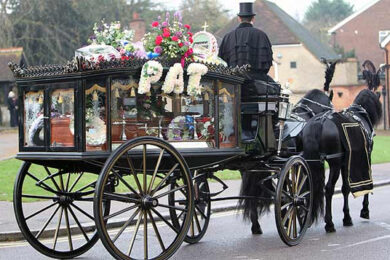"You were the daugh’er, the only little girl I ever really ‘ad. And despite every fink, I always had a feelin’ for you. You probably reminded me of meself. We don’t have to part on bad terms, not everybody has to part on bad terms…”
Oh yes they do, Pat, for this is the world of soap opera, the strand of television drama that shrugs off and shuns the very idea of a story having an ending, happy or otherwise. Everything has to be open, inconclusive and posing more questions than it could ever hope to answer. The curtain never falls, there is no final credit roll as the scene fades to black. The fact that EastEnders‘ title sequence, in the very episode in which Pat popped her clogs, and for the sixth time in the programme’s 27-year run, was altered so that the map of London included detail of the Olympic Stadium is an indicator that things move on.
Yet, there was something curiously final about Pat’s last few hours in Albert Square, and her exchange with Janine before finally succumbing to cancer; a denouement that spoke to a troubled dynasty, as if we were watching yer actual Shakespeare. Janine, lest we forget, was a step-child from Pat’s third marriage whose most notorious scene, back in 2004, saw her push Barry, a step-child from Pat’s fourth marriage, off a cliff during the couple’s honeymoon. Prime time story-telling rarely gets more Shakespearian than that.
And while Pat may tell the wayward Janine that she’s a chip off the old blousy block, we viewers know that she never will be. Because in 2012, the notion of a majestic, matriarchal figure casting a long dangly earringed shadow over the follies and foibles of younger generations isn’t something that’s debated for too long in script meetings, not when there’s photogenic former pop stars (Kym Marsh, Patsy Kensit) looking for work.
Pat may have wanted to pass the matriarchal baton on in a death-bed scene, but the 21st Century soap model has little use for stoical mother hens imparting wisdom to their descendants, be they blood-line or improbably welded together by misfiring marriages. The spotlight is ever brighter on younger faces, who can draw in equally young viewers via lads’ mag cover shoots or by showing a nifty pair of heels on Strictly Come Dancing.
The departure of Pat (Wicks/Butcher/Evans, depending on when you first tuned in) represents a further eroding of the idea of women of a certain age being a mainstay, or pivotal to a soap’s success.
Pam St Clement had initially been hired for just three episodes in 1986, turning up as the bad penny former prostitute first wife of Pete Beale, her arrival in the Square coinciding with the latest debris in her ex-hubby’s fractious relationship with his second wife Kathy. As well as jamming a spanner in the works of Pete’s domestic set-up, she made a play for landlord Den Watts in full view of the alcoholic, borderline mentally-ill Angie.
Before too long, however, the popularity of the character led writers to soften her image and make her an integral part of numerous other characters’ triumphs and tragedies. Almost every actor will tell you it’s more fun to play villains than it is heroes, but it’s interesting to note that so many characters brought in as bad eggs have bloomed into lovable ones.
It used to be standard soap practice; Barbara Knox’s Rita Sullivan may be a wise and regal presence in Coronation Street today, but her introduction in the early 70s was as the floozy mother of one of teacher Ken Barlow’s more difficult pupils. But although the older, kinder, gentler Rita has (so far) survived the producer’s axe, she has been relegated to an almost secondary player, given self-contained plot-lines that rarely send ripples across the rain-soaked cobbled streets of Weatherfield.
Rita’s still around, but the strong women of yore (Peggy Mitchell, Pauline Fowler, Vera Duckworth, and going back a few years Lou Beale, Bet Gilroy, Elsie Tanner and Ena Sharples) haven’t always been replaced by feminine folk of comparable clout.
Blanche Hunt’s Corrie farewell was forced upon producers after actress Maggie Jones’s death, but even though she was the revered head of a family it wasn’t in a traditional matriarchal sense, her acid-tongued pronouncements more in keeping with Maggie Smith’s dowager in Downton Abbey.
In all truth, the concept of a matriarch has been an anachronism for decades; perfectly feasible at the time of Coronation Street’s humble debut in 1960, when families were more close-knit and cash-strapped newlyweds lodging with in-laws was a common practice. That’s not typical of Britain today, but soaps have long had a tendency to drag their feet when it comes to reflecting reality.
Arguably, the only senior resident of any dramatic weight left in either of the UK’s Top Two soaps is Dot Cotton, who, alongside Ian Beale, is the only surviving character from the very first episode of EastEnders back in 1985. When 84-year-old June Brown finally calls it a day it will be front-page news, so much more than just another story about an actress quitting her job. In wider TV terms, it will most definitely be the end of an era.



